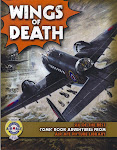 W. Richard Hutton's writing career seems to have begun during the Second World War but it was a year after V.E. Day, that he suddenly found success writing crime and western paperbacks for Hamilton & Co., who published eight of his short novels in only six months. Some were little more than pamphlets, but a rather more substantial series appeared in 1947-49 from Fiction House who published a run of murder mysteries featuring Detective Inspector Goldie of Scotland Yard in their Piccadilly Novels line.
W. Richard Hutton's writing career seems to have begun during the Second World War but it was a year after V.E. Day, that he suddenly found success writing crime and western paperbacks for Hamilton & Co., who published eight of his short novels in only six months. Some were little more than pamphlets, but a rather more substantial series appeared in 1947-49 from Fiction House who published a run of murder mysteries featuring Detective Inspector Goldie of Scotland Yard in their Piccadilly Novels line.Hutton had two hardcover Western novels published in 1950 by Quality Press but seems to have disappeared soon after that, perhaps into pseudonymous anonymity.
Beyond the 22 novels listed below, Hutton continues to remain frustratingly elusive. The only firm information I have on him is that he was the honorary secretary of the Bristol Writers' and Artists' Association writers' collective (chairman Leslie Urquhart-White [born Leslie Dorando White], 1909-1972), who published a miscellany of prose and verse entitled Bristol Packet in 1944, reviewed in the Western Mail (23 November 1944) thus:
"Bristol Packet," a publication which seems to have been inspired by the appearance of "Wales" and "The Welsh Review," makes its bow at half-a-crown a time in a bright green and white cover. There are more than 60 poems, articles and short stories, some by experienced writers, others by unknown contributors banded together in the Bristol Writers' Association, with Mr. W. R. Hutton, of 19, Cavendish-road, Henleaze, as secretary. The contents have a strong Bristol tang, but Wales is represented by two writers, Keidrych Rhys and Idris Davies. Altogether it is an attractive publication, with a special interest for those who have watched the progress of similar literary ventures in Wales.In March 1945, a report on an address by City Librarian James Ross at the Bristol Central Library, notes that the Bristol Writers' Association was present and a vote of thanks was proposed by Hutton (chairman), although the stated position may have been in error—all other mentions give his post as secretary.
In 1946 the Association was involved in setting up an exhibition of the work of a 30-year-old local artist named George Melhuish (1916-1985). After searching for available premises in Bristol and concluding that none could be found, the exhibition was moved to the Alpine Club in South Audley Street, London W1, where it ran between the 4th and 22nd of June 1946, partly funded by the Association from sales of stories by members.
Later in 1946, the Association, through Bristol-based Rankin Bros., published a slim volume of reproductions of Melhuish's work with an introductory essay by Hutton. This, as far as I can discover, is the last activity of the Association, although Hutton's connections with Bristol continued with the publication of two editions of Arrowsmith’s Guide to the City and County of Bristol in 1946-47.
The address given for Hutton in 1944 might offer a clue to his movements. The property was owned by Ernestine St John Kiddle, who died there on 26 March 1941. A few months later, her furniture and effects were auctioned off, along with the property itself, a stone-built, semi-detached house conveniently situated with level approach to Dudham Down, shops and 'bus services. The house was big: five bedrooms, one of which had an en suite kitchen, meaning that the upper floor could be let as a separate flat.
Hutton was definitely living at that address in 1944-46 but had probably left by 1950. According to the local phone book, 19 Cavendish Road was the residence of Griffith Leonard Tanswell (1902-1994) in 1950-54. What became of Hutton after that remains a mystery.
PUBLICATIONS
Novels
Dead Man’s Range. London, Hamilton, Jun 1946.
Sinister Mistress. London, Hamilton, 1946.
Trigger Fever. London, Hamilton, Nov 1946.
Riders of the Bar X. London, Hamilton, Dec 1946.
Rustlers of the Night. London, Hamilton, Dec 1946.
Valley of Death (by Richard Hutton). London, Hamilton, Dec 1946.
Broadway Racket. London, Hamilton, Dec 1946.
Dead Men Tell (by Johnnie James). London, Grant Hughes, Dec 1946.
Enduring Passion. London, Hamilton, Apr 1947.
Not A Dog’s Chance. London, Piccadilly Novels, Sep 1947.
Death At the Golden Cockerel. London, Piccadilly Novels, Jan 1948.
Death Of A Wide-Boy. London, Piccadilly Novels, Apr 1948.
Rough Riders. London, Grant Hughes, 1948.
Death At the Drome. London, Piccadilly Novels, Jul 1948.
Outlaw’s Town. Glasgow, Muir-Watson, Apr 1949.
Murder In Transit. London, Piccadilly Novels, Apr 1949.
Outlaw of Lost Canyon. London, Grant Hughes, Jun 1949.
Colt Justice. London, Grant Hughes, Oct 1949.
Injun Brand. London, Hamilton, May 1950.
A Gun Totin’ Hombre. London, Quality, Oct 1950.
Arapaho Charlie. London, Quality, Dec 1950.
Gunslinger’s Luck. London, Hamilton, Sep 1951.
Non-fiction
George Melhuish, with an introduction by W. Richard Hutton. Bristol, Bristol Writers' & Artists' Association, 1946.
Arrowsmith’s Guide to the City and County of Bristol, 1946-1947. Bristol, J. W. Arrowsmith, 1946.
Arrowsmith’s Guide to the City and County of Bristol, 1947-1948. Bristol, J. W. Arrowsmith, 1947.





































































































